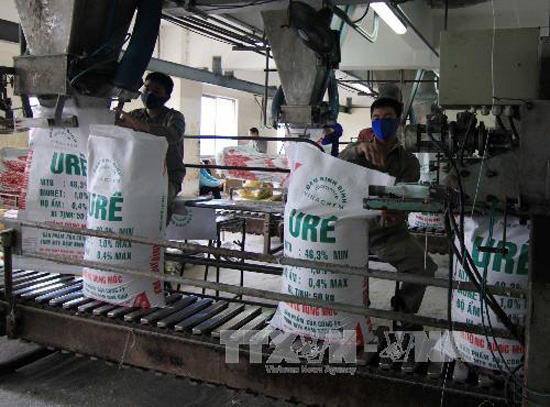
Closing of Urea products at Ninh Binh Urea factory. Illustrative photo: Vu Sinh/TTXVN
Rise in most important markets
The price of urea in Southeast Asia has increased by an additional 10 USD/ton due to tight supply. The price of granular urea in the Middle East is higher at 380 – 390 USD/ton FOB. The price of granular urea in Brazil remains stable at 380 – 385 USD/ton CFR.
According to Fetercon, a market research company, urea prices in Q1/2024 are trending upwards in many important markets due to tightening supply. In Asia, tight supply in Southeast Asia has pushed urea prices up to 390 – 400 USD/ton FOB, an increase of 10 USD/ton on both ends compared to the previous week.
In terms of supply, BFI (Brunei) is currently the only supplier in the region, with vessels currently being transacted at a price of 380 USD/ton FOB to Vietnam.
In Indonesia, the large urea producer PIHC is still awaiting export customs clearance and the situation will not be clear until after the general election in the country tomorrow (February 14).
Meanwhile, urea supply from Malaysia remains limited, with Petronas beginning scheduled maintenance at the Ure Gurun granular urea plant with a capacity of 700,000 tons/year from February 1 for a period of 45 – 60 days.
In Japan, urea producer Nissan Chemicals is making an effort to restart production after the suspended operation of the Toyama ammonia plant following an earthquake on January 1.
According to Argus Market Research Company, urea prices in China, one of the world’s largest urea production countries, have increased in Shandong, Sontay, Hebei, and Jiangsu due to increased purchases for winter storage and increasing international urea prices.
In the Middle East and Africa, urea prices have increased significantly due to tension in the Red Sea, which has pushed transportation costs higher. In addition, overall urea production capacity is limited in Iran due to issues with gas supply, with the Kermanshah (KPIC) urea plant with a capacity of 600,000 tons/year scheduled to be shut down for at least 25 days. MIS, Lordegan, and Khorasan suppliers have all stopped operating, while Pardis is operating at 66%, Shiraz at 70%, and Razi at 40% of normal production capacity.
The global urea market continues to rise in the context of tightening supply and increased demand from major markets. New contracts from Egypt have increased, but Egyptian producers are aiming for a price of 415 USD/ton FOB for the next transaction, even some suppliers have withdrawn from the market, waiting for further price developments. Currently, urea exports from Egypt have increased to 410 USD/ton FOB, but suppliers do not want to settle at a lower price.
In Africa, Algerian producers have committed to supplying enough urea in February but have adjusted their offering prices. Currently, producers are targeting 400 – 420 USD/ton FOB depending on the export destination, although many suppliers do not want to sell below 400 USD/ton FOB.
In the US, urea prices are also increasing, although Spring transactions have not yet begun. The price of urea traded by barges at Nola for February and March is settled at 360 USD/ton FOB.
According to Argus, urea demand in the US, Europe, Australia, and Southeast Asia is increasing amid tightening supply, which is one of the important reasons for the price increase. It is worth noting that the recent explosion of a fertilizer warehouse in Kwinana on December 8 has affected the fertilizer supply in the market.
In addition, India, the world’s largest importer of urea, is preparing to open bids for purchasing from 500,000 to 1 million tons at the end of February, and also plans to open bids for another round, which will continue to support the price of this fertilizer in the first quarter of 2024.
US market members believe that the upcoming bidding round in India could put additional pressure on urea prices, and spot prices may continue to increase as the country may absorb the entire supply for the Western Hemisphere and the tight market conditions in Asia will continue to exist.
However, Argus also predicts that China’s return to the export market in the coming period may cool down urea prices as it enters the second quarter of 2024.
Urea prices in Vietnam adjusted according to world prices
In recent weeks, urea prices in the domestic market have increased significantly as fertilizer demand for production has also increased.
Mr. Phung Ha, Vice Chairman and General Secretary of the Vietnam Fertilizer Association, said that export prices of agricultural products are currently favorable, especially for rice exports, so the demand for fertilizer to expand production has also increased. This is different from the same period in 2023 when many provinces experienced a significant decline in farmers quitting or suspending fertilizer application due to sharp drops in agricultural prices.
The Ministry of Agriculture and Rural Development of Vietnam also predicts that in 2024, Vietnamese agriculture will continue to achieve many achievements as the US, China, and many Middle Eastern countries prefer Vietnamese agricultural products. The impact of El Nino is forecasted to reduce global food supply, creating an opportunity for various Vietnamese agricultural products such as rice, durian, coffee, etc.
In addition, the cost of domestic urea production is increasing due to the increased cost of raw materials for urea production at the Phu My and Ca Mau urea plants. The increase in oil prices also affects the transportation cost of fertilizers and raw materials. Combined with the characteristics of the domestic fertilizer market closely linked to the international market, these factors have led to an increase in domestic urea prices.
Currently, the price of urea from Vietnam by PetroVietnam Fertilizer and Chemicals Corporation (PVCFC – Cà Mau fertilizer) delivered to Latin America is at the level of 390 – 400 USD/ton FOB. According to Argus, urea prices in Vietnam have increased in recent weeks due to many large producers shifting to export large quantities, causing tight domestic supply.
At this time, PetroVietnam Fertilizer and Chemicals Joint Stock Company (PVFCCo – Phu My fertilizer) has suspended exports to focus on the domestic market which has a higher demand in March and April with the arrival of the Spring season.
However, the Vietnam Fertilizer Association said that with stable urea supply from four large fertilizer manufacturers in Vietnam currently including PVFCCo, PVCFC, Ninh Binh Urea Joint Stock Company, and Ha Bac Fertilizer and Chemicals Joint Stock Company, urea demand for agriculture production during the peak of the spring season will be fully met and fertilizer prices may fluctuate according to world prices, but still under control.
In addition, all four major state-owned urea fertilizer production companies in Vietnam have thoroughly applied cost-saving solutions to their production and business activities, from strong digital transformation, flexible sales and distribution policies to ensure the best fertilizer prices for farmers, and enhance competitiveness with cheap imported fertilizer products. Therefore, domestic fertilizer prices have a basis to be maintained at a balanced level of benefits between businesses and farmers, supporting agricultural development, Mr. Phung Ha, Vice Chairman, and General Secretary of the Vietnam Fertilizer Association said.





































